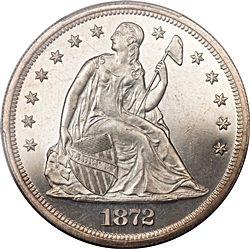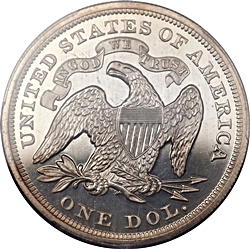 |
1872
 

|
 |
General Comments
|
| |||||||||||||||||||||
In the lower grades, the population reports show that over 300 of the business strikes graded are less than VF20. This is a huge jump from most other dates, far more than any other date except 1871. The greatest availability is in the XF-AU55 range. In general, all grades of 1872 short of the gem designation are readily available and will bring prices consistent with what most price guides would indicate.
1872 examples are seldom fully struck. They often display softness on the star centrals, sometimes to the point that some of the stars may be completely flat. Less often they display weakness on the upper left-wing feathers and the eagle’s neck feathers. Locating a well struck example will be a challenge, but they can be found. High-grade business strikes are sometimes prooflike or semi-prooflike, but more often frosty. With a mintage of over one million the dies wore sufficiently to give most examples a pleasing mint frost. But examples are available for those who love prooflike surfaces.
1872 Die Marriages
15 die marriages have been positively identified, among the most for any issue in the series. Several are surprisingly scarce. 9 obverse dies were paired with 5 reverses to strike 14 business strike die pairs. One of the reverse dies was transitional from 1871. No business strike dies were used for proofs. I’ve identified no re-marriages for the year, but the dies wore very little, so identifying the re-marriages is difficult. Some may exist. A single proof die marriage is known, pairing two unique dies that were used for the first time in 1872. The reverse die was used again for 1873 proofs. A few examples of the proof die marriage have been seen in business strike holders. However, I’ve seen only a single business strike in a proof holder, unusually low for the series. That coin was lightly circulated, graded AU50, so the mistake was an easy one to make.
The following table summarizes the known die marriages for 1872. Click the highlighted links to view the details of each marriage.
Die Marriage |
Rarity |
Obverse Die |
Reverse Die |
Estimated Survivors |
| OC-1 | R3 | 1 | 1871 C | 340 |
| OC-2 | R4- | 1 | A | 200 |
| OC-3 | R1 | 2 | A | 1765 |
| OC-4 | R2 | 3 | B | 800 |
| OC-5 | R2 | 2 | B | 660 |
| OC-6 | R4+ | 4 | B | 100 |
| OC-7 | R2 | 5 | C | 720 |
| OC-8 | R2 | 6 | C | 560 |
| OC-9 | R5+ | 7 | C | 45 |
| OC-10 | R4 | 8 | D | 130 |
| OC-11 | R5- | 8 | B | 80 |
| OC-12 | R5+ | 8 | C | 35 |
| OC-13 | R5 | 5 | D | 55 |
| OC-14 | R7- | 9 | C | 10 |
| OC-P1 | R2 | P1 | PA | 575 |
1872 Business Strike Emission Sequence
The emission sequence required several assumptions, since several die marriages shared no dies.
I assumed that OC-1 was the first issue since it used a reverse die first used in 1871. I've
seen only pictures of two of the rare die marriages. I wouldn't be surprised if changes to the
sequence are necessary when I’m able to personally examine examples of these die marriages. I
identified no re-marriages for the year, but based on my findings in other high-mintage years
it’s very likely that some exist. The lack of significant wear on most of the dies makes them
very difficult to identify.
Emission Order |
Die Marriage |
Comments |
| 1 | OC-1 | I assumed that the marriage which included the reverse die first used in 1871 was the first issue. |
| 2 | OC-2 | Reduction in unfinished areas on the obverse due to die polishing. |
| 3 | OC-3 | Reverse A die cracks indicate that OC-3 followed OC-2. |
| 4 | OC-4 | Placement of OC-4 is arbitrary since no dies were shared with the previous marriages. |
| 5 | OC-5 | Advancing Reverse B die cracks indicate that OC-5 followed OC-4. |
| 6 | OC-6 | Advancing Reverse B die cracks indicate that OC-6 followed OC-5. |
| 11 | OC-11 | Advancing Reverse B die cracks indicate that OC-11 followed OC-6. |
| 12 | OC-12 | Die polishing reduced unfinished areas on Obverse 8 indicating the OC-12 followed OC-11. |
| 10 | OC-10 | Die polishing reduced unfinished areas on Obverse 8 indicating the OC-10 followed OC-12. |
| 13 | OC-13 | Advancing Reverse D die wear indicates that OC-13 followed OC-10. |
| 7 | OC-7 | Die polishing reduced the unfinished areas on Obverse 5 indicating the OC-7 followed OC-13. |
| 8 | OC-8 | Reverse C die polish indicates that OC-8 followed OC-7. |
| 9 | OC-9 | Reverse C die polish indicates that OC-9 followed OC-8. |
| 14 | OC-14 | Reverse C die polish indicates that OC-14 followed OC-9. |
1872 Proof Emission Sequence
With only a single proof die marriage identified the emission sequence is simple.
Emission Order |
Die Marriage |
Comments |
| 1 | OC-P1 |
1872 Quick Finder Chart
All reverse dies have notable markers. First identify the reverse die, then determine the date position.
The table below shows the best best markers to allow quick attribution.
Die Marriage |
Obv Die |
Rev Die |
Right |
1st 1 |
Keys |
| OC-1 | 1 | 1871 C | LE | VSL | Obverse: Low date slanting down. Reverse: A faint die line joins the middle of WE in the motto. |
| OC-2 | 1 | A | LE | VSL | Obverse: Low date slanting down. Reverse: Doubled die reverse. Lump on the motto between TR, near the left side of the R. |
| OC-3 | 2 | A | RE | L | Obverse: MPD's - 2 in rock, 2 from rock. Reverse: Doubled die reverse. Lump on the motto between TR, near the left side of the R. |
| OC-4 | 3 | B | RE | C | Obverse: Die line from shield edge below shield line 5-1. Die lines below heel. Reverse: Lump between the shaft and upper right serif of the 1st T in TRUST. |
| OC-5 | 2 | B | RE | L | Obverse: MPD's - 2 in rock, 2 from rock. Reverse: Lump between the shaft and upper right serif of the 1st T in TRUST. |
| OC-6 | 4 | B | JR of C | VSH | Obverse: Lump in gown left of pole. Reverse: Lump between the shaft and upper right serif of the 1st T in TRUST. |
| OC-7 | 5 | C | JL of C | SH | Obverse: Die line extends down from chin. Reverse: Die line through left side of O in GOD. Lump attached to the lower loop of G. |
| OC-8 | 6 | C | JR of C | VH | Obverse: Lump under chin. Reverse: Die line through left side of O in GOD. |
| OC-9 | 7 | C | JR of LE | SL | Obverse: Lump under chin. Reverse: Die line through left side of O in GOD. |
| OC-10 | 8 | D | L QTR | H | Obverse: MPD below 7. Reverse: A large lump just right of the lower serif of the E in WE. |
| OC-11 | 8 | B | L QTR | H | Obverse: MPD below 7. Reverse: Lump between the shaft and upper right serif of the 1st T in TRUST. |
| OC-12 | 8 | C | L QTR | H | Obverse: MPD below 7. Reverse: Die line through left side of O in GOD. Lump attached to the lower loop of G. |
| OC-13 | 5 | D | JL of C | SH | Obverse: Die line down from chin. Reverse: A large lump just right of the lower serif of the E in WE. |
| OC-14 | 9 | C | RE | VSH | Obverse: Die line in denticles below 8. NO die lines below heel. Reverse: Die line through left side of O in GOD. Lump attached to the lower loop of G. |
| OC-P1 | P1 | PA | LE | SH | Obverse: Die line in shield recess #6 above the T in LIBERTY. Reverse: Strong doubled die reverse. |
| Photo credits:
Obverse and reverse full photos: 1872 PCGS PR66 Cameo, among the finest known, from the Heritage archives. |
